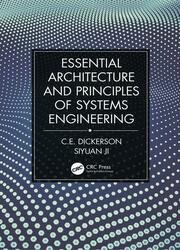 Название: Essential Architecture and Principles of Systems Engineering Название: Essential Architecture and Principles of Systems Engineering
Автор: C.E. Dickerson, Siyuan Ji
Издательство: CRC Press
Год: 2022
Страниц: 261
Язык: английский
Формат: pdf (true)
Размер: 18.6 MB
This book is for everyone interested in systems and the modern practice of engineering. The revolution in engineering and systems that has occurred over the past decade has led to an expansive advancement of systems engineering tools and languages. A new age of information-intensive complex systems has arrived with new challenges in a global business market. Science and information technology must now converge into a cohesive multidisciplinary approach to the engineering of systems if products and services are to be useful and competitive.
For the non-specialist and even for practicing engineers, the subject of systems engineering remains cloaked in jargon and a sense of mystery. This need not be the case for any reader of this book and for students no matter what their background is. The concepts of architecture and systems engineering put forth are simple and intuitive. Readers and students of engineering will be guided to an understanding of the fundamental principles of architecture and systems and how to put them into engineering practice.
This book offers a practical perspective that is reflected in case studies of real-world systems that are motivated by tutorial examples. The book embodies a decade of research and very successful academic instruction to postgraduate students that include practicing engineers. The material has been continuously improved and evolved from its basis in defence and aerospace towards the engineering of commercial systems with an emphasis on speed and efficiency. Most recently, the concepts, processes, and methods in this book have been applied to the commercialisation of wireless charging for electric vehicles.
The aim of the first two Modelling Languages Chapters is to introduce the Unified Modeling Language (UML). As compared to the published standards of UML, these two chapters offer a distilled version of how to use its modelling concepts and elements to model and represent a system with UML diagrams. The concepts and knowledge covered in this chapter and the next provide the necessary toolkit for accomplishing the essential activities of System and Architecture Definition.
In the Chapter 10 we will visit the extensions introduced by the Systems Modeling Language (SysML) and explain how some of the key SysML diagrams can complement UML to achieve the modelling of physical elements, interfaces, and requirements. To aid the learning of SysML, a running example of diesel vehicle subsystems modelling for the purpose of vehicle emissions control and reduction will be used to explain the model elements and modelling concepts introduced by SysML.
As a postgraduate or professional development course of study, this book will lead you into the modern practice of engineering in the twenty-first century. Much more than a textbook, though, Essential Architecture and Principles of Systems Engineering challenges readers and students alike to think about the world differently while providing them a useful reference book with practical insights for exploiting the power of architecture and systems.
Скачать Essential Architecture and Principles of Systems Engineering
|